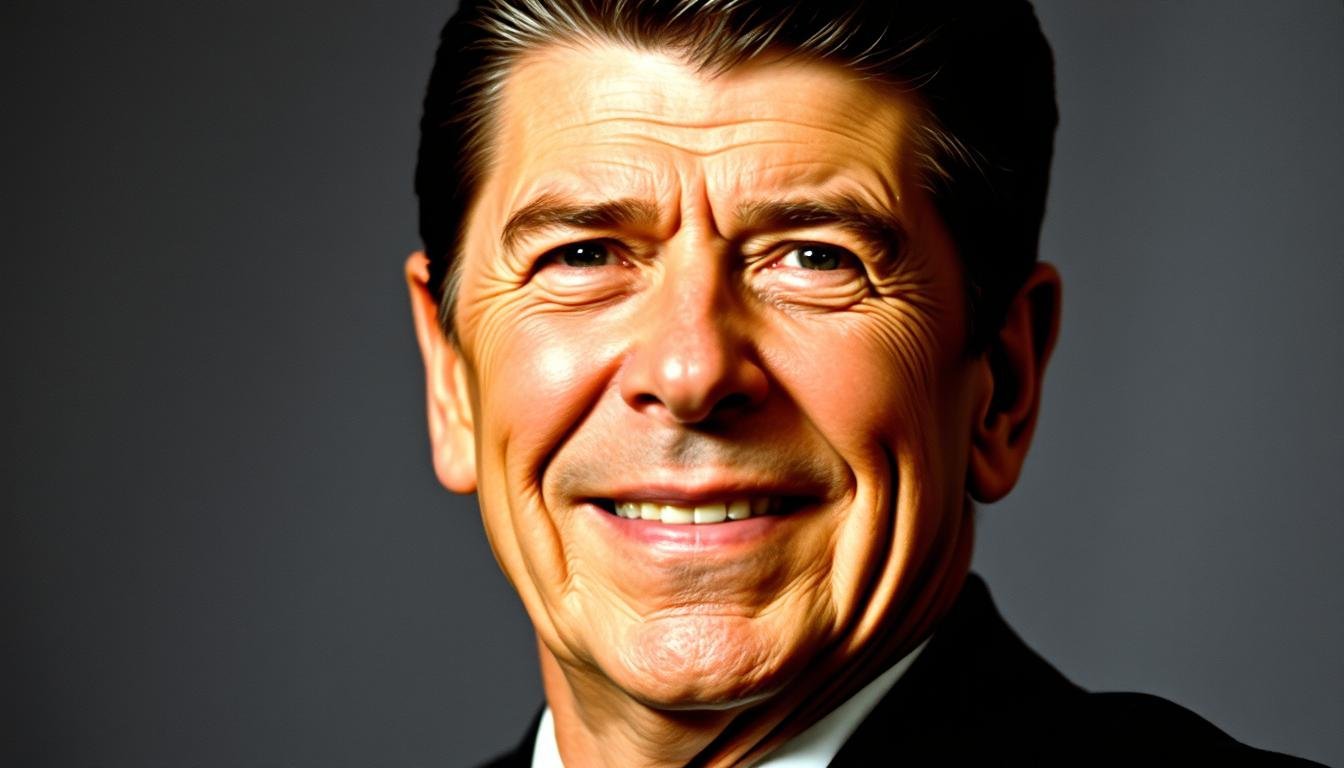Why Was Reagan Called the “Teflon President”? Have you ever wondered why Ronald Reagan was called the “Teflon President”? This nickname came from his amazing ability to keep a positive image. He did this even when he faced many controversies during his time in office.
Ronald Reagan went through tough times, like economic downturns and foreign policy issues. But he kept his approval ratings high. This made him known as the “Teflon President.” You’ll learn what made him so popular and why this nickname is important for understanding his presidency.
Contents
- 1 The Origin of the “Teflon President” Nickname
- 2 Why Was Reagan Called the “Teflon President”?
- 3 Major Controversies That Failed to Damage Reagan’s Popularity
- 4 The Secret Behind Reagan’s Teflon Coating
- 5 The Role of Reagan’s White House Team
- 6 The Teflon Presidency in Historical Context
- 7 Reagan’s Enduring Legacy as the Teflon President
- 8 FAQ: Why Was Reagan Called the “Teflon President”?
- 8.1 What does the term “Teflon President” refer to?
- 8.2 How did Ronald Reagan maintain his popularity?
- 8.3 What were some of the major controversies during Reagan’s presidency?
- 8.4 How did Reagan’s White House team contribute to his “Teflon coating”?
- 8.5 Is the term “Teflon President” still relevant today?
- 8.6 How has historical context influenced the perception of Reagan’s presidency?
- 8.7 What can be learned from Reagan’s ability to maintain his popularity?
The Origin of the “Teflon President” Nickname
Ever wondered how Ronald Reagan got the “Teflon President” nickname? It started in the 1980s during his presidency. The term came from his skill to avoid criticism and controversy, just like Teflon doesn’t stick to surfaces.
Reagan’s critics first called him the “Teflon President” to point out his ability to dodge scandals. Despite many challenges during hisReagan presidency, he stayed popular.
Several things helped earn him this nickname:
- Reagan’s effective communication skills
- His ability to connect with the American public
- A charismatic persona that helped him navigate through tough times
Reagan’s presidency was filled with big events. His “Teflon” reputation helped him get through many tough times. Knowing where this nickname came from helps us understand the political climate back then and Reagan’s lasting impact.
Why Was Reagan Called the “Teflon President”?
You might wonder how Reagan kept his popularity despite controversies. This is why he was called the “Teflon President.” The term “Teflon” means something that doesn’t stick, like a non-stick coating. For Reagan, it meant he could go through tough times without it affecting his image.
Reagan’s charm and communication skills were key. They helped him dodge criticism. His ability to touch people’s hearts also kept his popularity high.
Here is a summary of the key factors that contributed to Reagan’s “Teflon President” nickname:
| Factor | Description | Impact |
|---|---|---|
| Charm and Communication | Reagan’s ability to effectively communicate and his charming personality | Helped deflect criticism and maintain a positive public image |
| Emotional Connection | Reagan’s ability to connect with the American public emotionally | Maintained his popularity despite controversies |
| Media Handling | Reagan’s administration was skilled at managing media coverage | Minimized negative coverage and emphasized positive aspects |
Reagan’s presidency was filled with big events and controversies. Yet, his “Teflon” coating stayed strong until the end. Understanding why he remained popular gives us a peek into the world of politics and image management.
Major Controversies That Failed to Damage Reagan’s Popularity
Ronald Reagan faced many challenges during his presidency. He was the 40th US President and had to deal with several big controversies. Yet, his popularity stayed high, earning him the nickname “Teflon President.”
The Iran-Contra affair was a big scandal. In 1986, it was found that Reagan’s team sold arms to Iran and used the money for rebels in Nicaragua. This raised big questions about the legality and ethics of their actions. But, Reagan’s approval ratings didn’t drop much.
Reagan also faced criticism for his economic policies. The 1982 recession was tough, with high joblessness and a big budget deficit. But, the economy started to grow again, known as the “Reagan Boom.” This helped his popularity.
The following table summarizes some of the major controversies during Reagan’s presidency and their impact on his popularity:
| Controversy | Description | Impact on Popularity |
|---|---|---|
| Iran-Contra Affair | Secret sale of arms to Iran and funding of anti-Sandinista rebels | Minimal impact |
| Economic Recession (1982) | High unemployment rates and large budget deficit | Temporary decline, followed by recovery |
| Escalation of the Cold War | Increased military spending and tensions with the Soviet Union | Limited impact, seen as a necessary measure |
Reagan’s skill in handling controversies without losing popularity was impressive. His ability to connect with the American people was key. This shows how his resilience helped keep his popularity high.
The Secret Behind Reagan’s Teflon Coating
Many wonder how Reagan stayed popular despite scandals. His “Teflon coating” came from charm, good communication, and a skilled White House team.
Reagan’s charm was key in connecting with Americans. His friendly, down-to-earth nature made him easy to like. This likability helped deflect criticism and keep his popularity high.

Reagan’s team used clever tactics to keep his image positive. They managed news cycles well, often using humor to shift focus away from bad news. Here are some of their strategies:
- Managing media appearances for positive coverage
- Using humor to dodge criticism
- Introducing new initiatives to distract from controversies
The Role of Reagan’s White House Team
Reagan’s White House team played a big role in his Teflon coating. They worked hard to handle crises, often preventing big scandals. Their skill helped Reagan stay out of trouble.
The team’s approach included:
| Strategy | Description | Impact |
|---|---|---|
| Crisis Management | Anticipating and mitigating potential issues | Reduced negative coverage |
| Media Management | Managing news cycles for positive coverage | Boosted public support |
Reagan’s charm and the team’s strategies helped keep his image positive, even with many controversies.
The Teflon Presidency in Historical Context
Looking back at Ronald Reagan’s presidency, his ‘Teflon Presidency’ is a key topic. It shows how he kept public support even when faced with controversies. This term is linked to Reagan’s skill in staying popular.
Reagan was in office from 1981 to 1989. This period saw big changes, like the end of the Cold War and the growth of conservative politics. His leadership and communication skills helped him stay popular.
The ‘Teflon Presidency’ is more than Reagan’s charm. It also shows the 1980s’ politics and economy. Economic growth and a strong anti-communist stance helped him stay popular.
Reagan’s presidency was a turning point in American politics. It brought a shift to conservatism and boosted American confidence worldwide. Understanding the ‘Teflon Presidency’ helps us see Reagan’s lasting impact on American politics.
Reagan’s Enduring Legacy as the Teflon President
Ronald Reagan was called the “Teflon President” for his ability to stay popular. He faced many controversies but kept his image strong. He handled economic troubles and foreign policy crises well.
His nickname shows his skill in talking to people and connecting with them. This helps us understand what makes a president popular. It shows how important public image is.
Reagan’s time in office is a big part of American history. His “Teflon” reputation is still talked about by historians and political experts. His way of dealing with problems helped shape his legacy and his place in American politics.
See Also: Can a US Marshal Arrest the President?
FAQ: Why Was Reagan Called the “Teflon President”?
What does the term “Teflon President” refer to?
The term “Teflon President” refers to Ronald Reagan‘s ability to stay popular. This was despite being surrounded by controversies during his presidency.
How did Ronald Reagan maintain his popularity?
Reagan kept his popularity by being a great communicator and having a charming personality. His White House team also managed controversies well.
What were some of the major controversies during Reagan’s presidency?
Major controversies included the Iran-Contra affair and criticisms of his economic handling. His stance on social issues was also a topic of debate.
How did Reagan’s White House team contribute to his “Teflon coating”?
Reagan’s team was key in keeping his popularity high. They managed crises well, controlled the narrative, and lessened controversy impact.
Is the term “Teflon President” still relevant today?
Yes, the term “Teflon President” is still relevant today. It refers to a politician’s ability to withstand criticism and keep public support despite controversies.
How has historical context influenced the perception of Reagan’s presidency?
Historical context has greatly shaped how we view Reagan’s presidency. Factors like the end of the Cold War and the economy during his term have played a role.
What can be learned from Reagan’s ability to maintain his popularity?
Reagan’s success teaches us about the value of effective communication and crisis management in politics. It shows the importance of strong leadership.

Hi, I am Tatum Bradford from Washington. I have a background in political science and work as a senior revenue officer. I love learning about U.S. presidents and sharing interesting facts about political history.

